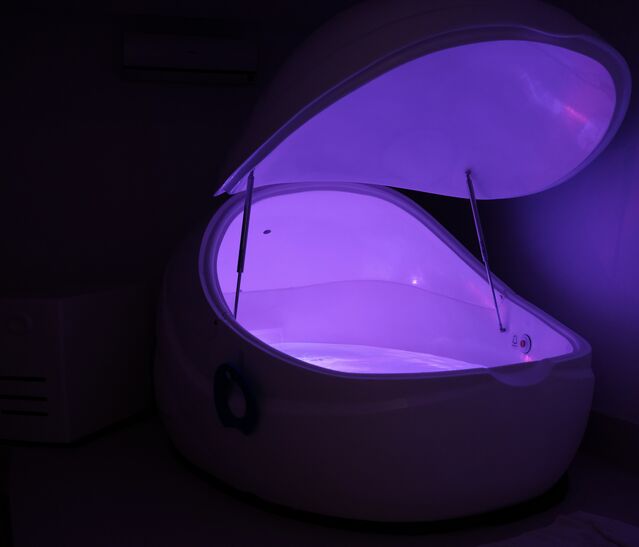Default Mode Network
How Floating in Darkness Takes the Body off the Mind
Recent research reveals how sensory isolation tanks affect brain activity.
Updated January 1, 2024 Reviewed by Kaja Perina
Key points
- Sensory reduction "float tanks" are a promising therapy for anxiety.
- Scientists have measured the effects of sensory reduction on functional brain connecitivity using neuroimaging
- Volunteers had resting brain scans befor/after sessions of sensory reduction (floating or reclining in chair)
- Sensory reduction decreases relationships within/between brain areas linked to mind-wandering and the body

What happens when your mind disconnects from all outside sensations?
First, you undress, put in earplugs, and step into a floatation tank, the water warmed to the temperature of your skin and saturated with Epsom salt. You hardly feel the water and you float effortlessly given its high salinity. Next, you close the lid of the tank and are greeted by darkness. You see nothing, hear nothing, feel nothing …
Or do you? Recent research into so-called “sensory deprivation” tanks reveals that, despite the moniker, the experience in these tanks is more like sensory enhancement. Patients with clinical anxiety learn not only to feel their breath and heartbeat, but to also perceive these sensations as pleasant and less linked to anxiety.
Furthermore, the same researchers at Laureate Institute for Brain Research (LIBR) in Tulsa, Oklahoma responsible for the above finding have also found huge reductions in short-term anxiety after patients float for just 60 minutes. This suggests that sensory reduction, which can be experienced at commercial float centers in many cities, is a novel therapy for forgetting old associations between visceral sensations (like your heart beating) and anxiety and learning new associations between these sensations and relaxation (after all, you can’t be panicking and relaxing in water at the same time).
Floating changes brain networks
But how does floating affect brain activity? To find out, researchers at LIBR lead by Justin Feinstein scanned the brains of 24 healthy volunteers before and immediately after three weekly float sessions of 90 minutes each. Using functional magnetic resonance imaging or fMRI, they compared the results with data collected from a separate group that reclined in a memory foam chair in a dark room for three sessions instead of floating. The results show that communication or “functional connectivity” within and between brain networks, as inferred from correlations between activity in different brain regions, decreased in both conditions. This reduced communication might be a signature of sensory reduction in multiple contexts, including floating and resting in a chair.
Especially striking were findings concerning the brain’s default mode network (DMN), which is involved in mind-wandering or self-referential processes. The DMN tends to come online when participants are asked to just rest and not do anything in particular, the very instructions that study volunteers were given during the fMRI scans. Just as research with meditation has shown that this network shuts off when mental chatter is quieted and a person focuses attention on present moment sensations, the researchers found that connectivity within and between hubs, or important communication sites, of the DMN is greatly reduced after floating. Furthermore, connectivity between the DMN and another network responsible for bodily representations, the somatomotor network, is also weaker after sensory reduction. Although both conditions—lying in a chair and floating—showed similar patterns of reduced connectivity, the float condition showed the greatest decrease.
The mind-body relationship
The authors’ finding that floating decouples the DMN (responsible for mental chatter) from the somatomotor network (responsible for bodily representations) is tersely summarized in the paper’s title as “Taking the body off mind.” I asked Dr. Feinstein if this presents a paradox (how, after all, does floating take the body off the mind while enhancing interoception, or one’s ability to feel sensations within one’s body)?
“Most of the interoceptive enhancement we’re seeing is during the float itself,” Dr. Feinstein told me over Zoom. “We didn’t actually look at an active interoceptive task during resting state [when participants’ brains were scanned].” Because fMRI requires a giant magnet, it’s not possible to scan participants’ brains inside the float tank, so what the researchers found after the float experience might be slightly different from what happens in the brain during sensory reduction.
But back to the title—what does it mean? “The brain’s representation of the body as mapped in the somatosensory cortices is what showed the biggest reduction in connectivity post-float, and the degree of this reduction was related to the degree of serenity induced by the float experience. When paired with the reduced connectivity that was found in the posterior DMN, the findings suggest that floating induces a sort of homeostasis within the mind’s representation of the body.”

Altered states of consciousness
This reduction in connectivity, while recorded after participants float, could possibly relate to out-of-body experiences that are occasionally reported in the tank. “Floating fundamentally alters all of the afferent sensory information that’s coming into the brain via the body, creating this homeostatic state of quiescence,” said Dr. Feinstein. “Suddenly, you don’t have gravitational forces. Suddenly, you don’t have all of this proprioceptive muscle tension. And now for the first time, the brain is experiencing the body in an environment devoid of gravity and proprioception. It’s a very unique state in that way … You can’t really simulate the float state outside of sending someone to outer space.”
The specific involvement of the posterior DMN (i.e., parts of the network toward the back of the cerebral cortex) might speak to its greater involvement in conscious awareness as compared to the anterior DMN (i.e., parts of the network toward the front of the cerebral cortex), a comparison that is hotly debated at the moment by neuroscientists (see here and here). “The anterior default mode [network] is not a necessary prerequisite for conscious states or self-awareness. It’s clearly involved, but it’s not necessary,” said Dr. Feinstein, who himself has published work on a patient with preserved self-awareness despite extensive frontal brain damage. “Whereas I think these posterior regions of the default mode [network] are necessary, and if you were to damage them … you would see a much more causal effect in terms of its relation to consciousness and self-awareness.”
Future studies
What’s next for float research? “I’m continuing to collaborate very closely with [study coauthor] Sahib Khalsa,” said Dr. Feinstein, “and he’s actually found ways to do fMRI studies where he injects anxious patients with a synthetic form of adrenaline while they’re in the scanner to get at a very pure heart-brain connection.” Future studies might actually look at how floating protects patients from anxiety when they’re later challenged with adrenaline after floating, all while scanning their brains and acquiring new data to test hypotheses about how floating reduces anxiety.
The LIBR team’s current work was published in the journal Human Brain Mapping in April.

References
Al Zoubi, O., Misaki, M., Bodurka, J., Kuplicki, R., Wohlrab, C., Schoenhals, W.A., Refai, H.H., Khalsa, S.S., Stein, M.B., Paulus, M.P. and Feinstein, J.S., 2021. Taking the body off the mind: Decreased functional connectivity between somatomotor and default‐mode networks following Floatation‐REST. Human brain mapping.




